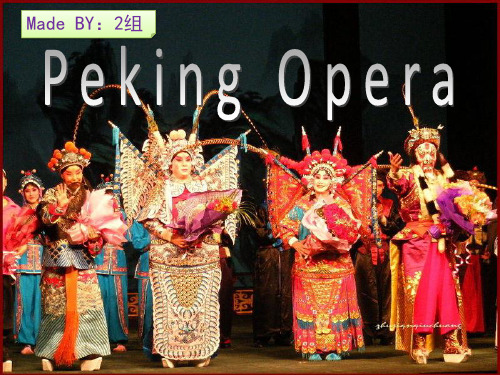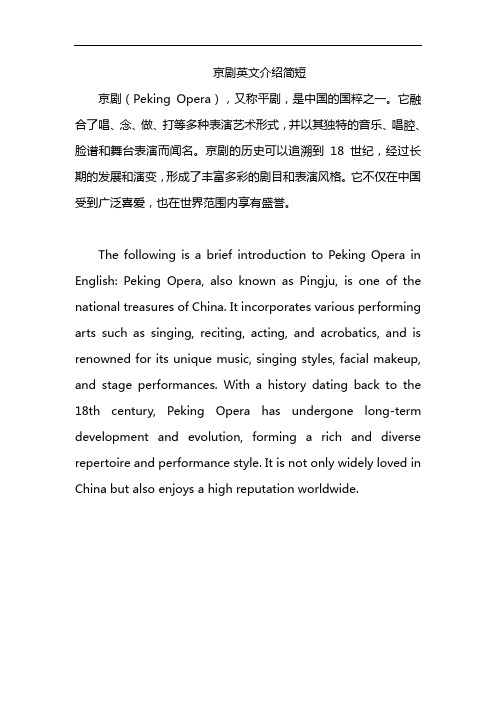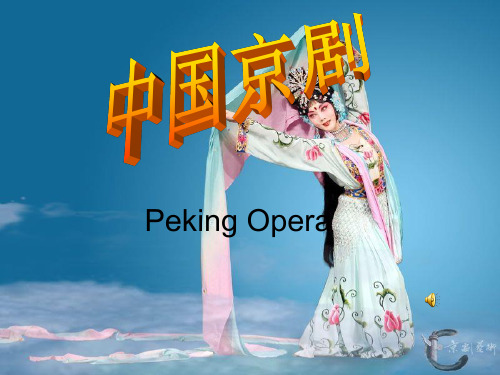京剧英文介绍
京剧英文介绍

da
nce movements to bring the story to life on stage.
5
Costumes are often vibrant and extravagant, designed to enhance the visual impact of the
performanc
Each role has their own set of gestures and movements that are specific to their
character and gender. For example, male roles often perform strong an
d forceful movements, while female roles
The style of Peking Opera is unique, with performers relying on facial expressions and gesturesto convey emotions and characters. The use of cmoasstkusm,esp,rops, and stage design also plays an important role in enhancing the performance. Peking Opera also features a unique music style with instru
Tshfioslilowed by the five acts, each containing
2
different plots and themes. The performance concludes with a finale called the "Curtain Call"
Peking opera京剧英文介绍

1. In 1915, for the first time Mei used the spotlight 追光 in Peking Opera.
Beijing opera reached maturity between 1883 and
1918. This was partly because the Empress Dowager Cixi became a regular patron of it. In this period, the leading figures are Tan Xinpei , Wang Guifen and Sun Juxian who were called ”The three post giants of Housheng”.
•Peking Opera evolved from Kunqu Opera, an even more ancient art of drama listed by UNESCO in 2001 among the first group of works representing humankind through oral history.
2. In 1923, Mei was inspired to add erhu to the accompaniment of Peking opera, which enriched its background music.
主要用金、银色,或在辅色中添勾 金、银色线条和涂色块,以示神圣 威严。
京剧英文介绍简短

京剧英文介绍简短
京剧(Peking Opera),又称平剧,是中国的国粹之一。
它融合了唱、念、做、打等多种表演艺术形式,并以其独特的音乐、唱腔、脸谱和舞台表演而闻名。
京剧的历史可以追溯到18 世纪,经过长期的发展和演变,形成了丰富多彩的剧目和表演风格。
它不仅在中国受到广泛喜爱,也在世界范围内享有盛誉。
The following is a brief introduction to Peking Opera in English: Peking Opera, also known as Pingju, is one of the national treasures of China. It incorporates various performing arts such as singing, reciting, acting, and acrobatics, and is renowned for its unique music, singing styles, facial makeup, and stage performances. With a history dating back to the 18th century, Peking Opera has undergone long-term development and evolution, forming a rich and diverse repertoire and performance style. It is not only widely loved in China but also enjoys a high reputation worldwide.。
京剧的英文介绍[精彩]
![京剧的英文介绍[精彩]](https://img.taocdn.com/s3/m/7a06c56ab14e852459fb5796.png)
生 Sheng: main male role主要男性
角色
旦
Dan: young and beautiful female 年轻、漂亮的女
Origin起源
❖ Although it is called Peking Opera, the origins of Peking Opera are not in Beijing but in the provinces of Anhui (East China) and Hubei (South-central China). Its rise is due in great part to the favorable eyes and patronage of the imperial royalties.虽然它被 称为京剧,京剧的起源不在北京,但在中国东部 省份安徽(中国)和湖北省中南部的)。它在很 大程度上是由于上升的有利的眼睛和惠顾帝 王的版税。
❖ The influence of Western culture has also left the younger generations impatient with the slow pacing of Beijing opera.西方文化的影响也离开了年轻一代的同意 太慢了京剧nted faced male画面临男性
丑
❖ Chou: clown, male or female小丑,男性或女 性
The status of Beijing Opera京剧的 地位
中国京剧英文介绍

1. Beijing Opera, also known as Peking Opera, is a traditional Chinese art form that combines singing, dancing, martial arts, and acrobatics. It originated in Beijing during the late 18th century and has since become one of the most popular forms of Chinese opera.京剧,也被称为北京剧,是一种融合了唱、舞、武术和杂技的中国传统艺术形式。
它起源于18世纪末的北京,成为中国最受欢迎的戏曲之一。
2. The distinctive features of Beijing Opera include elaborate costumes, stylized makeup, and complex vocal techniques. Performers wear brightly colored costumes and use exaggerated movements to portray their characters. The makeup, known as "jing," is highly symbolic and helps the audience distinguish between different roles.京剧的独特特点包括精致的服装、风格化的化妆和复杂的声乐技巧。
演员穿着鲜艳的服装,并通过夸张的动作来表现角色。
化妆,被称为“京”,具有很高的象征性,并帮助观众区分不同的角色。
3. Beijing Opera combines various storytelling techniques, such as singing, spoken dialogue, and mime. The singing style, known as "xiangsheng," involves a unique combination of singing and recitation. The performers use specific gestures and movements to convey emotions and actions.京剧融合了各种叙事技巧,如唱、说和默剧。
中国京剧简介(英文)

Yellow
types of facial makeup in operas that vicious brutality, such as Dian Wei
Blue or green
types of facial makeup in operas that some of the figures represented irritable, such as Dou Ambassador(窦尔敦), Ma Wu .
General treacherous court official said the types of facial makeup in operas
white, bad guys,
such as Xu jia
Beijing opera is a traditional fortune of our country. Though it is difficult to perform, we can enjoy it if it is reformed .
京腔
昆曲
汉调
秦腔
Beijing Opera is a comprehensive performing arts. That is, sing, read and do, fight, dance.
梅兰芳 程砚秋
Four Great Famous Actress Role
苟慧生
向小云
The faction of peking
净
净(roles with painted faces): (1)文净(civilian type) (2)武净(warrior type)
丑
chou or clown (a comic character ): (1)文丑(civilian clown) (2)武丑(clown with martial skills)
京剧英文介绍1000字

京剧英文介绍1000字English.Beijing Opera (京剧, Jīngjù) is one of the most celebrated and iconic forms of Chinese traditional opera.It is renowned for its elaborate costumes, stunning makeup, and highly stylized singing and acting techniques. Beijing Opera originated in Beijing during the mid-19th century and quickly became popular throughout China. It is now considered one of the most important and influential forms of Chinese performing art.Characteristics of Beijing Opera.Beijing Opera is characterized by its unique combination of music, singing, dialogue, martial arts, acrobatics, and mime. The performance is divided into three main sections: the overture, the play, and the epilogue. The overture typically consists of a series of instrumental pieces that set the mood for the play. The play is the mainpart of the performance and tells a story through a combination of singing, dialogue, and action. The epilogueis a short section that concludes the play and provides a moral or philosophical message.Beijing Opera is also known for its elaborate costumes and makeup. The costumes are often very colorful and adorned with intricate embroidery. The makeup is highly stylized and helps to create the characters' personalities and emotions.Performance Techniques.Beijing Opera actors undergo rigorous training tomaster the specialized performance techniques that are required for this art form. The singing is characterized by a high-pitched, nasal style that is unique to Beijing Opera. The actors also use a variety of hand gestures, body movements, and facial expressions to convey emotions and actions.Roles.Beijing Opera characters are classified into four main types: sheng (male), dan (female), jing (painted face), and chou (clown). Each type of role has its own unique set of conventions and techniques.Themes.Beijing Opera plays often explore themes of history, legend, love, and betrayal. They often draw on stories from Chinese mythology and folklore, as well as historical events.Influence.Beijing Opera has had a profound influence on Chinese culture and society. It has been featured in numerous films, television shows, and stage productions. The art form has also been exported to other countries around the world, where it has been adapted and incorporated into local performing arts traditions.Significance.Beijing Opera is considered a national treasure ofChina and is protected by the government. It is a livingart form that continues to evolve and adapt to modern audiences. Beijing Opera is a testament to the richcultural heritage of China and its enduring artistic traditions.中文回答:京剧,又称京戏,是中国传统戏曲中最著名、最具代表性的形式之一。
京剧中英文介绍

参考资料:百度京剧在塑造人物方面有其独特的造型语言。
它把不同性别、性格、年龄、身份的人物划分为不同的行当,一般说来有"生、旦、净、丑"四大行当。
由于京剧人物造型形象鲜明、风格多样,有强烈的剧场效果,常常更易于激起观众的欣赏兴趣。
生行京剧中的"生",一般指剧中扮演男子的演员,其中又可细分为"老生"、"小生"和"武生"。
"老生",顾名思义就是中老年男子角色,在剧中多扮演正直刚毅的人物形象,例如京剧《伍子胥》中的伍子胥.他们演出时要戴挂在耳朵上的假胡须,在京剧的行话中也叫"髯口",因此还专门有一套髯口上的表演功夫。
胡须的颜色表示了人物的年龄。
京剧《四郎探母》中的杨四郎年约三十岁,所戴胡须为黑色。
京剧《秦香莲》中王延龄年约六十,所戴胡须为白色。
老生在剧中一般注重演唱和细腻表演,唱腔上也最为丰富。
台词用京剧中的韵白来表现,演唱用真声,风格刚劲、挺拔、质朴、醇厚,动作造型也以雍容、端方、庄重为基调。
与老生相对应的是"小生",在京剧中指青少年男子角色,他们在剧中的动作造型儒雅倜傥、秀逸飞动。
在演唱上采用真假声结合的唱法,演唱风格华美和明亮。
例如京剧《白蛇传》中的许仙."武生"是指扮演剧中年轻的男性武将,他们用高超的武打技术来展示剧中人物的武艺高强。
不重演唱,注重武打动作的娴熟和技巧的难度。
例如京剧《长坂坡》中的赵云.Role of ShengThe roles on the Chinese opera stage fall intofour categories -- Sheng, Dan, Jing and Chou.These roles have the natural features of age andsex, as well as social status, and areartificially exaggerated by makeup, costume andgestures.Sheng, a male role, usually a leading one, datesback to Southern Drama of the Song and YuanDynasties (960-1368). This role appears inoperas in all historical periods. According tothe age and social status of the characters,Sheng falls into five sub-groups: Laosheng,Xiaosheng, Wusheng, Hongsheng and Wawasheng(characters of children).Laosheng is also known as Xusheng, meaningbearded men, because the actors wear artificialbeards, and they are middle-aged or elderly men.Most are upright and resolute characters. Theysing in their natural voices, and their actionsare serious ones.Xiaosheng is a sub-category of Shengrepresenting young male characters. They don'twear artificial beards. They always sing intheir real voices, while in Kunqu and Pihuangoperas the singing mixes natural and falsettovoices.Wusheng stands for all of the male characterswho appear in battle scenes. They are furthersubdivided into Changkao Wuheng, Duanda Wusheng,Goulian Wusheng and Houxi Wusheng. They alwayswear helmets and thick-soled boots. The generalsalways carry long pikes. Wusheng roles call forsturdy and vigorous actions, with resoundingdeclamations. The movements of the waist andlegs are powerful, and a high level of martialarts skills is demanded in these roles. DuandaWusheng roles use short-handled weapons, andtheir movements are light and swift.旦行京剧中把女性统称为"旦",其中按照人物的年龄、性格又可细分为许多行当,饰演大家闺秀和有身份的妇女称为"正旦",正旦在京剧中俗称"青衣",这就是因为正旦所扮演的角色常穿青色的长衫而得名。
- 1、下载文档前请自行甄别文档内容的完整性,平台不提供额外的编辑、内容补充、找答案等附加服务。
- 2、"仅部分预览"的文档,不可在线预览部分如存在完整性等问题,可反馈申请退款(可完整预览的文档不适用该条件!)。
- 3、如文档侵犯您的权益,请联系客服反馈,我们会尽快为您处理(人工客服工作时间:9:00-18:30)。
types of facial make-up in Beijing opera
In China the art form has been known by many other names in different times and places. The earliest Chinese name was a combination of the Xipi and Erhuang mng.
The Sheng is the main male role in Peking opera. This role has numerous subtypes. The laosheng is a dignified older role. These characters have a gentle and cultivated disposition and wear sensible costumes. Young male characters are known as xiaosheng. These characters sing in a high, shrill voice with occasional breaks to represent the voice changing period of adolescence. Depending on the character's rank in society, the costume of the xiaosheng may be either elaborate or simple.Offstage, xiaosheng actors are often involved with beautiful women by virtue of the handsome and young image they project.The wusheng is a martial character for roles involving combat. They are highly trained in acrobatics, and have a natural voice when singing.
As it increased in popularity, its name became Jingju or Jingxi, which reflected its start in the capital city, Jing, and the form of the performance, Xi. From 1927 to 1949, Beijing was known as Beiping, and Peking opera was known as Pingxi or Pingju to reflect this change. Finally, with the establishment of the People's Republic of China, the name of the capital city was reverted to Beijing, and the formal name of Beijing theatre in Mainland China was established as Jingju.
Peking opera was born when the 'Four Great Anhui Troupes' brought Anhui opera, or what is now called Huiju, to Beijing in 1790, for the birthday of the Qianlong Emperor. It was originally staged for the court and only made available to the public later. In 1828, several famous Hubei troupes arrived in Beijing and performed jointly with Anhui troupes. The combination gradually formed Peking opera's melodies. Peking opera is generally regarded as having fully formed by 1845. Although it is called Peking opera (Beijing theatre style), its origins are in the southern Anhui and eastern Hubei, which share the same dialect of Xiajiang Mandarin .
The Dan refers to any female role in Peking opera. Dan roles were originally divided into five subtypes. Old women were played by laodan, martial women were wudan, young female warriors were daomadan, virtuous and elite women were qingyi, and vivacious and unmarried women were huadan. One of Mei Lanfang's most important contributions to Peking opera was in pioneering a sixth type of role, the huashan. This role type combines the status of the qingyi with the sensuality of the huadan. A troupe will have a young Dan to play main roles, as well as an older Dan for secondary parts.
